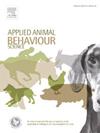Behavioural complexity in fattening pigs II. Accelerometer-based validation of a novel welfare indicator with potential for automation
IF 2.2
2区 农林科学
Q1 AGRICULTURE, DAIRY & ANIMAL SCIENCE
引用次数: 0
Abstract
The interest in automated methods of continuously monitoring the behaviour of farm animals, particularly by means of accelerometers, is growing because behaviour is of specific importance for the assessment of welfare beyond health. At the same time, the need for animal-based and individual-specific welfare indicators has been theoretically recognised. Behavioural complexity could be such an indicator with the potential for automation. In this study, we investigated accelerometer data from 97 fattening pigs – recorded on 185 days in three age classes, two seasons, and four housing levels – to assess behavioural complexity. First, we used a binary classifier to automatically predict phases of low and high activity as a basis for calculating behavioural complexity from the accelerometer data. Second, we trained and validated a random forest classifier to predict eight different behavioural states. The binary classification of activity phases achieved an accuracy of 77 % and the random forest model an accuracy of 84 %. For the binary and the random forest data, five and 12 complexity-features, respectively, were reduced using PCA and the resulting PCs were analysed using mixed effects models. In the binary data, general complexity (PC 1) was higher with higher housing levels (p [housing level] = 0.01; p [global] = 0.07) and duration variability (PC 2) tended to be so (p [housing level] = 0.08; p [global] = 0.38). Additionally, there was a tendency towards higher general complexity in older pigs (p [age] = 0.06). For the random forest data, general complexity (PC1) was lower on average with higher housing levels (without statistical support: p [housing level] = 0.14; p [global] = 0.48) and there was a tendency for a higher transition rate (PC2) with higher housing levels (p [housing level] = 0.07; p [global] = 0.52). These results suggest that the higher behavioural complexity seen in more animal-friendly housing environments can also be observed in automatically recorded data classified in binary phases of low and high activity. The classifier-features calculated from accelerometer data collected from head movements could not unequivocally differentiate between the different behaviours. Therefore, the random forest model could not precisely predict the behaviours needed as the basis to calculate behavioural complexity. All observed patterns were relatively weak such that the observed sensitivity of these automatically recorded variables (PCs) in respect to the housing system is unlikely to translate easily into sufficient specificity for future assessment of welfare of individual animals.
育肥猪的行为复杂性2。基于加速计的新型福利指标的验证,具有自动化的潜力
人们对持续监测农场动物行为的自动化方法,特别是利用加速计的方法越来越感兴趣,因为行为对于评估健康以外的福利具有特别重要的意义。与此同时,基于动物和个人特定的福利指标的必要性在理论上已经得到承认。行为复杂性可能就是这样一个具有自动化潜力的指标。在这项研究中,我们调查了97头育肥猪的加速度计数据,这些数据记录在185天内,分为三个年龄等级、两个季节和四个猪舍水平,以评估行为复杂性。首先,我们使用二元分类器自动预测低活动和高活动的阶段,作为从加速度计数据计算行为复杂性的基础。其次,我们训练并验证了一个随机森林分类器来预测八种不同的行为状态。活动阶段的二元分类准确率为77 %,随机森林模型的准确率为84 %。对于二进制和随机森林数据,分别使用PCA减少了5个和12个复杂性特征,并使用混合效应模型分析了所得pc。在二元数据中,住房水平越高,一般复杂性(pc1)越高(p[住房水平]= 0.01;p [global] = 0.07)和持续时间变异性(pc2)倾向于如此(p[住房水平]= 0.08;P [global] = 0.38)。此外,老龄猪的总体复杂性有较高的趋势(p [age] = 0.06)。对于随机森林数据,一般复杂性(PC1)随住房水平的提高而降低(无统计支持:p[住房水平]= 0.14;p [global] = 0.48),住房水平越高,过渡率(PC2)越高(p [housing level] = 0.07;P [global] = 0.52)。这些结果表明,在动物更友好的住房环境中看到的更高的行为复杂性也可以在自动记录的数据中观察到,这些数据分为低活动和高活动的二元阶段。从头部运动收集的加速度计数据中计算出的分类器特征不能明确区分不同的行为。因此,随机森林模型不能精确预测作为计算行为复杂性基础所需的行为。所有观察到的模式都相对较弱,因此观察到的这些自动记录变量(PCs)在住房系统方面的敏感性不太可能轻易转化为足够的特异性,以便将来评估单个动物的福利。
本文章由计算机程序翻译,如有差异,请以英文原文为准。
求助全文
约1分钟内获得全文
求助全文
来源期刊

Applied Animal Behaviour Science
农林科学-行为科学
CiteScore
4.40
自引率
21.70%
发文量
191
审稿时长
18.1 weeks
期刊介绍:
This journal publishes relevant information on the behaviour of domesticated and utilized animals.
Topics covered include:
-Behaviour of farm, zoo and laboratory animals in relation to animal management and welfare
-Behaviour of companion animals in relation to behavioural problems, for example, in relation to the training of dogs for different purposes, in relation to behavioural problems
-Studies of the behaviour of wild animals when these studies are relevant from an applied perspective, for example in relation to wildlife management, pest management or nature conservation
-Methodological studies within relevant fields
The principal subjects are farm, companion and laboratory animals, including, of course, poultry. The journal also deals with the following animal subjects:
-Those involved in any farming system, e.g. deer, rabbits and fur-bearing animals
-Those in ANY form of confinement, e.g. zoos, safari parks and other forms of display
-Feral animals, and any animal species which impinge on farming operations, e.g. as causes of loss or damage
-Species used for hunting, recreation etc. may also be considered as acceptable subjects in some instances
-Laboratory animals, if the material relates to their behavioural requirements
 求助内容:
求助内容: 应助结果提醒方式:
应助结果提醒方式:


